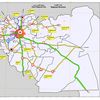Homs Governorate:Homs Governorate Regional Plan
Disciplines
-
Masterplanning
-
Urban Infrastructure & Utilities
-
Transportation
Companies
Dorsch International Consultants
Client
Homs Governorate
Duration
From 2008 to 2009Project Activities
- Comprehensive data collection campaign
- Field validation of collected data
- Organization, compilation and archiving of data, data base development, base map preparation, modeling of different scenarios for energy production, water resources protection and exploitation
- Workshops for coordination and harmonization of planning priorities
- Reports preparation, maps preparation
- Validation workshops
Contact
Dorsch International Consultants GmbH
München (Headquarters)
80687 München
Germany
Phone: +49 89 5797-0
Fax: +49 89 5797-800
E-Mail: info@dorsch.de
Description
The Syrian Government established the planning level and corresponding implementation tools for the REGIONAL PLAN, in order to bridge the gap between the Five-Year Plan and the local master plan. The governorate of Homs with its central location in Syria (being also the largest) with its great variety of ecological conditions and land uses, and covering the largest area of all governorates, thus served as model and pilot project.
It included project management by providing a methodology of Regional Planning as well as the collection, selection, edition and maintenance of all relevant data useful for Regional Plan which significantly increased the availability of high-quality, timely and reliable data. The Regional Plan was based on a GIS system, and a comprehensive database which composed the . planning concept that had to be approved by all governmental and regional stakeholders, especially the administrative Managers of the Governorate and of the State.
Analysis of the different topics was carried out and served as base for the integrated Regional Plan. A SWOT-analysis and a sustainable planning concept for every sector (such as agriculture, industry, housing development, traffic and transport infrastructure, economy, cultural heritage, energy and telecommunication, water supply and wastewater treatment, solid waste, ...) was developed and an interactive prioritizing of competing land uses and resources protection was prepared and coordinated with the local administration.
The final Regional Plan integrated the sector objectives, measures and action plans and proposed solutions for competing interests and was validated on a common ground with all stakeholders.

